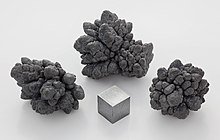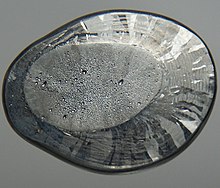Lead (pronounce: "/'lɛd/") is a chemical element. Its chemical symbol is Pb, which comes from plumbum, the Latin word for lead.[6] Its atomic number is 82, atomic mass is 207.2 and has a melting point of 327.8°C. It is a very poisonous and heavy metal, and is also the ending element to the stable elements, although the next element, bismuth, is so weakly radioactive that it can be considered stable for practical purposes.[7]
 | ||||||||||||||||||||||||||||||||||||||||||||||||||||||||||||||||||
| Lead | ||||||||||||||||||||||||||||||||||||||||||||||||||||||||||||||||||
|---|---|---|---|---|---|---|---|---|---|---|---|---|---|---|---|---|---|---|---|---|---|---|---|---|---|---|---|---|---|---|---|---|---|---|---|---|---|---|---|---|---|---|---|---|---|---|---|---|---|---|---|---|---|---|---|---|---|---|---|---|---|---|---|---|---|---|
| Pronunciation | /ˈlɛd/ | |||||||||||||||||||||||||||||||||||||||||||||||||||||||||||||||||
| Appearance | metallic gray | |||||||||||||||||||||||||||||||||||||||||||||||||||||||||||||||||
| Standard atomic weight Ar°(Pb) | ||||||||||||||||||||||||||||||||||||||||||||||||||||||||||||||||||
| [206.14, 207.94][1] | ||||||||||||||||||||||||||||||||||||||||||||||||||||||||||||||||||
| Lead in the periodic table | ||||||||||||||||||||||||||||||||||||||||||||||||||||||||||||||||||
| ||||||||||||||||||||||||||||||||||||||||||||||||||||||||||||||||||
| Group | group 14 (carbon group) | |||||||||||||||||||||||||||||||||||||||||||||||||||||||||||||||||
| Period | period 6 | |||||||||||||||||||||||||||||||||||||||||||||||||||||||||||||||||
| Block | p-block | |||||||||||||||||||||||||||||||||||||||||||||||||||||||||||||||||
| Electron configuration | [Xe] 4f14 5d10 6s2 6p2 | |||||||||||||||||||||||||||||||||||||||||||||||||||||||||||||||||
| Electrons per shell | 2, 8, 18, 32, 18, 4 | |||||||||||||||||||||||||||||||||||||||||||||||||||||||||||||||||
| Physical properties | ||||||||||||||||||||||||||||||||||||||||||||||||||||||||||||||||||
| Phase at STP | solid | |||||||||||||||||||||||||||||||||||||||||||||||||||||||||||||||||
| Melting point | 600.61 K (327.46 °C, 621.43 °F) | |||||||||||||||||||||||||||||||||||||||||||||||||||||||||||||||||
| Boiling point | 2022 K (1749 °C, 3180 °F) | |||||||||||||||||||||||||||||||||||||||||||||||||||||||||||||||||
| Density (near r.t.) | 11.34 g/cm3 | |||||||||||||||||||||||||||||||||||||||||||||||||||||||||||||||||
| when liquid (at m.p.) | 10.66 g/cm3 | |||||||||||||||||||||||||||||||||||||||||||||||||||||||||||||||||
| Heat of fusion | 4.77 kJ/mol | |||||||||||||||||||||||||||||||||||||||||||||||||||||||||||||||||
| Heat of vaporization | 179.5 kJ/mol | |||||||||||||||||||||||||||||||||||||||||||||||||||||||||||||||||
| Molar heat capacity | 26.650 J/(mol·K) | |||||||||||||||||||||||||||||||||||||||||||||||||||||||||||||||||
Vapor pressure
| ||||||||||||||||||||||||||||||||||||||||||||||||||||||||||||||||||
| Atomic properties | ||||||||||||||||||||||||||||||||||||||||||||||||||||||||||||||||||
| Oxidation states | −4, −2, −1, 0,[2] +1, +2, +3, +4 (an amphoteric oxide) | |||||||||||||||||||||||||||||||||||||||||||||||||||||||||||||||||
| Electronegativity | Pauling scale: 1.87 (+2) | |||||||||||||||||||||||||||||||||||||||||||||||||||||||||||||||||
| Ionization energies |
| |||||||||||||||||||||||||||||||||||||||||||||||||||||||||||||||||
| Atomic radius | empirical: 175 pm | |||||||||||||||||||||||||||||||||||||||||||||||||||||||||||||||||
| Covalent radius | 146±5 pm | |||||||||||||||||||||||||||||||||||||||||||||||||||||||||||||||||
| Van der Waals radius | 202 pm | |||||||||||||||||||||||||||||||||||||||||||||||||||||||||||||||||
| Other properties | ||||||||||||||||||||||||||||||||||||||||||||||||||||||||||||||||||
| Natural occurrence | primordial | |||||||||||||||||||||||||||||||||||||||||||||||||||||||||||||||||
| Crystal structure | face-centered cubic (fcc) | |||||||||||||||||||||||||||||||||||||||||||||||||||||||||||||||||
| Speed of sound thin rod | 1190 m/s (at r.t.) (annealed) | |||||||||||||||||||||||||||||||||||||||||||||||||||||||||||||||||
| Thermal expansion | 28.9 µm/(m⋅K) (at 25 °C) | |||||||||||||||||||||||||||||||||||||||||||||||||||||||||||||||||
| Thermal conductivity | 35.3 W/(m⋅K) | |||||||||||||||||||||||||||||||||||||||||||||||||||||||||||||||||
| Electrical resistivity | 208 nΩ⋅m (at 20 °C) | |||||||||||||||||||||||||||||||||||||||||||||||||||||||||||||||||
| Magnetic ordering | diamagnetic | |||||||||||||||||||||||||||||||||||||||||||||||||||||||||||||||||
| Molar magnetic susceptibility | −23.0×10−6 cm3/mol (at 298 K)[3] | |||||||||||||||||||||||||||||||||||||||||||||||||||||||||||||||||
| Young's modulus | 16 GPa | |||||||||||||||||||||||||||||||||||||||||||||||||||||||||||||||||
| Shear modulus | 5.6 GPa | |||||||||||||||||||||||||||||||||||||||||||||||||||||||||||||||||
| Bulk modulus | 46 GPa | |||||||||||||||||||||||||||||||||||||||||||||||||||||||||||||||||
| Poisson ratio | 0.44 | |||||||||||||||||||||||||||||||||||||||||||||||||||||||||||||||||
| Mohs hardness | 1.5 | |||||||||||||||||||||||||||||||||||||||||||||||||||||||||||||||||
| Brinell hardness | 38–50 MPa | |||||||||||||||||||||||||||||||||||||||||||||||||||||||||||||||||
| CAS Number | 7439-92-1 | |||||||||||||||||||||||||||||||||||||||||||||||||||||||||||||||||
| History | ||||||||||||||||||||||||||||||||||||||||||||||||||||||||||||||||||
| Discovery | in the Middle East (7000 BCE) | |||||||||||||||||||||||||||||||||||||||||||||||||||||||||||||||||
| Symbol | "Pb": from Latin plumbum | |||||||||||||||||||||||||||||||||||||||||||||||||||||||||||||||||
| Isotopes of lead | ||||||||||||||||||||||||||||||||||||||||||||||||||||||||||||||||||
Isotopic abundances vary greatly by sample[5] | ||||||||||||||||||||||||||||||||||||||||||||||||||||||||||||||||||

Properties
changePhysical properties
changeLead is a shiny, gray-blue poor metal. It gets tarnished easily to a dull gray color. It is soft and malleable. It is very shiny when it is melted. It is very heavy. It is very corrosion-resistant. It is made stronger by adding antimony or calcium. It can form an alloy with sodium. It is toxic to people and animals when swallowed.
Chemical properties
changeLead burns in air with a grayish-white flame, making toxic fumes of lead(II) oxide. Only the surface is corroded by air. It dissolves in nitric acid to make lead(II) nitrate. It does not dissolve in sulfuric or hydrochloric acid. It reacts with sodium nitrate to make lead(II) oxide and sodium nitrite. It reacts with chlorine to make lead(II) chloride. Lead(II) oxide reacts with lead sulfide to make lead metal and sulfur dioxide.
Chemical compounds
changeLead makes chemical compounds in two main oxidation states: +2 and +4. +2 compounds, also known as lead(II) compounds or plumbous compounds, are weak oxidizing agents. +4 compounds, also known as lead(IV) compounds or plumbic compounds, are strong oxidizing agents. Lead compounds are toxic just like the element. The lead halides do not dissolve in water. Lead(IV) oxide is the most common lead(IV) compound. It is a black solid. The lead oxides are all colored, while the other salts are white or colorless. Lead nitrate and lead(II) acetate are the soluble compounds of lead.
- +2 compounds
This state is more common than the +4 state. These are weak oxidizing agents. All but the oxides are colorless or white.
- Lead(II) acetate, colorless soluble
- Lead(II) arsenate, insoluble former pesticide
- Lead(II) bromide, insoluble
- Lead(II) carbonate, white, used as pigment
- Lead(II) chloride, insoluble
- Lead(II) nitrate, soluble, colorless
- Lead(II) oxide, red or yellow
- Lead(II) sulfate, white, found in lead acid batteries
- Lead(II) sulfide, black, common as mineral
- Mixed oxidation state compounds
Mixed oxidation state compounds contain lead in the +2 and +4 oxidation state.
- Lead(II,IV) oxide, red, oxidizing agent
- +4 compounds
These are less common. They are strong oxidizing agents.
- Lead(IV) acetate, oxidizing agent, colorless
- Lead(IV) oxide, dark brown, oxidizing agentCobalt compounds are chemical compounds containing cobalt ions.
-
Lead(II) chloride
-
Lead(II) nitrate
-
Lead(IV) oxide
-
Lead(II,IV) oxide
-
Lead(II) oxide
Occurrence
change-
Lead found in the ground
-
Galena
Lead is found very rarely in the earth's crust as a metal. Normally, lead is in the mineral galena. Galena is lead sulfide. Galena is the main lead ore.
History
changeLead was used for thousands of years because it is easy to get from the ground and easy to shape and work with. The Romans used lead very commonly. They used it for pipes, drinking vessels, and fasteners.
Preparation
changeLead is made from galena. Galena is made pure by froth flotation to get all the impurities out. Then the lead sulfide is roasted in a furnace to make lead(II) oxide. The lead(II) oxide is heated with coke to make liquid lead metal.
Uses
changeAs an element
changeLead is used in the ballast of sailboats. It is also used in weight belts for scuba diving. It is also used to make shotgun pellets and bullets for small arms. Some printing presses use lead type because it can be easily shaped. It can be used outside because it does not corrode in water.
Most lead is used in lead acid batteries, though. The lead is oxidized, making electricity. Sheets of lead are used to block sound in some places. Lead is used in radiation shielding. Molten lead can be used as a coolant in nuclear reactors. It used to be mixed with tin to make the pipes in pipe organs. Different amounts of lead make different sounds. In addition, lead has found its usage in solder.
It is used in some solder. It is used in covering for wires that carry high voltage. Some tennis rackets have lead in them to make them heavier. It is used to balance wheels of cars, to make statues, and to make decorative looks in buildings.
As chemical compounds
changeMany lead compounds are used to make colored glazes in ceramics. Lead can be used in PVC pipes. Lead compounds are added to candles to make them burn better. Lead glass has lead(II) oxide in it. Lead compounds are still used as pigments in some places. Lead compounds were added to gasoline, but are now outlawed. Some lead compounds are semiconductors and are used in photodetectors.
Old uses
changeLead was used in many red, yellow, and white pigments in paints. Lead was also used in pesticides. Lead used to be used in pipes carrying water, but now it is not because lead can leach into the water.
Safety
changeAlthough it can be safely touched, exposure to lead should be avoided – it is very toxic to humans and other animals when swallowed, and its use is restricted in many countries.
If someone is exposed to lead for a long time, it ruins their kidneys and gives them abdominal pains. Lead also ruins the nervous system. Lead paint was being eaten by children and they were getting lead poisoning.
The best way to understand lead and its properties is to read its MSDS.
Related pages
changeReferences
change- ↑ "Standard Atomic Weights: Lead". CIAAW. 1969.
- ↑ Pb(0) carbonyls have been observered in reaction between lead atoms and carbon monoxide; see Ling, Jiang; Qiang, Xu (2005). "Observation of the lead carbonyls PbnCO (n=1–4): Reactions of lead atoms and small clusters with carbon monoxide in solid argon". The Journal of Chemical Physics. 122 (3): 034505. 122 (3): 34505. Bibcode:2005JChPh.122c4505J. doi:10.1063/1.1834915. ISSN 0021-9606. PMID 15740207.
- ↑ Weast, Astle & Beyer 1983, p. E110.
- ↑ Kondev, F. G.; Wang, M.; Huang, W. J.; Naimi, S.; Audi, G. (2021). "The NUBASE2020 evaluation of nuclear properties" (PDF). Chinese Physics C. 45 (3): 030001. doi:10.1088/1674-1137/abddae.
- ↑ 5.0 5.1 Meija et al. 2016.
- ↑ "Discovering Roman Technology". BBC. Archived from the original on 2009-02-16. Retrieved 2009-10-03.
- ↑ "Is Bismuth Radioactive? Setting the Record Straight". The Bismuth Smith. The Bismuth Smith Inc. Retrieved 8 March 2024.

